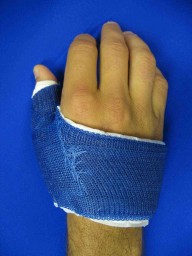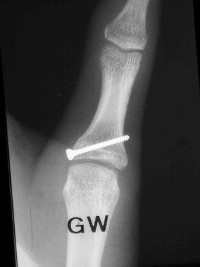Skier's Thumb
Thumb Function:
The thumb represents 40% of the hand function. Any injury to the thumb can result in significant dysfunction in the hand.
The priorities for the thumb are for it to be:
1. Stable
2. Painfree

Full movement is not so critical in the thumb. Loss of movement in the fingers in contrast is a major problem. There are 2 ligaments in the thumb MCP joint. The ulnar collateral ligament is more important and more commonly injured. Every time you hold something between you thumb and fingers you are relying on the ulnar collateral ligament. For this reason it is vital to allow the ligament to heal properly. ( Anatomy - More Information )
Many people consider it a minor injury and don't seek help or cease splinting prematurely. This can result in chronic laxity of the ligament which causes a weak grip and can result in chronic pain within the joint. It also makes the joint prone to further spraining injuries.
Normal Rupture Ulnar collateral ligament

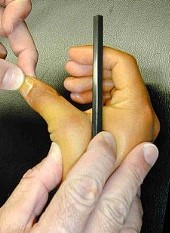
General:
This is a common injury among skiers and rugby footballers but can affect anyone.
It involves an injury to the Ulnar collateral ligament of the thumb. (See diagram).
It occurs when the thumb is bent back away from the fingers eg from a ski stock, or in a football tackle.
The ligament may pull a fragment of bone away from the base of the proximal phalanx.
If the fragment is displaced then this is an indication for surgery.
The degree of instability can be considerable when the thumb is assessed under anaesthetic ( as above ).
Surprisingly complete tears are often less painful than partial tears.


Alternatively the ligament may fold back upon itself and even with prolonged splintage the joint will remain unstable.
This is called a Stener lesion. ( More Information )



The green Adductor tendon normally overlies the yellow Ulnar Collateral ligament.
When the ligament tears it can fold back on itself and is held in this position by the overlying adductor tendon.
This diagram shows the adductor tendon divided to reveal the displaced ligament tear.
Classification of Skiers Thumb injuries: ( More Information )
- 1. Minor sprain
- 2. Partial tear/ stable
- 3. Complete tear/ unstable
X-ray:
- No fracture
- Fracture - Undisplaced
- Displaced
Treatment: ( More Information )
- Prevention of Injury ( More Information )
- Fibreglass cast
- Thermoplastic splint
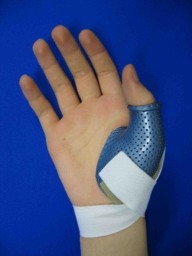
Splintage is used continuously for 4 - 6 weeks then intermittently for a further 4 - 6 weeks
eg. when ever you are holding anything (i.e. 2 - 3 months)
- Surgery:
- indicated if the joint is unstable or the fracture is displaced
- Involves direct repair of the ligament back to the bone using a bone anchor or fixing the fracture with a wire or screw
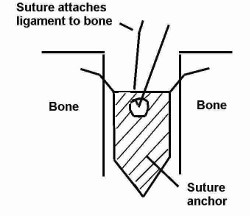
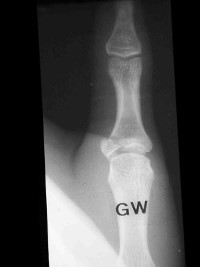
Post operatively:
Following the ligament repair the thumb is rested in a plaster slab until the sutures are removed at 7 -10 days.
The thumb is then immobilised for a variable period of time in a fibreglass cast (3-6 weeks) depending on the strength of the repair.
Exercises can then be commenced but a splint should be warn at all times when holding objects for 2-3 months.
Results:
- Often there is some permanent stiffness in the joint following the repair but this is deemed preferable to instability. On average 10 degrees of movement is lost from the 2 end joints of the thumb due to sticking down of the tendons with scar tissue.
- The irritability in the joint may take 6 months to settle.
- The scar may be sensitive for several months after the surgery. This usually settles with scar massage using hand cream eg Vitamin E cream and Silicone Gel applied to the scar.
LAST UPDATED 28 / 7 / 21

